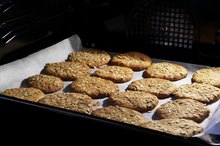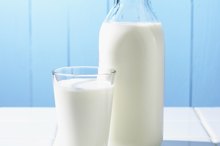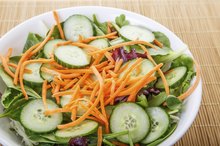How Much Oatmeal Is Needed to Reduce Cholesterol?
Some of the simplest foods are the most healthful. That’s the case with oatmeal, a whole grain that requires hot water to produce a quick, filling, heart-healthy breakfast. A bowl of oatmeal made with ½ cup of rolled oats provides 4 g of fiber along with 150 calories, 2.5 g of fat, 27 g of carbohydrates and no sugar. The fiber can benefit your cardiovascular health by helping to reduce your cholesterol.
Fiber and Cholesterol
Fruits, vegetables, whole grains, beans and legumes are good sources of fiber, and most Americans probably don’t eat enough of it. The Cleveland Clinic explains that while insoluble fiber -- roughage -- helps your digestion, soluble fiber has been shown to reduce LDL, the so-called bad cholesterol. Soluble fiber binds to fats, including cholesterol in your intestines, and helps to remove it from your body.
Soluble Fiber in Oats
Is Hummus a Low-Cholesterol Food?
Learn More
Like many other high-fiber foods, oatmeal provides both soluble and insoluble fiber. According to the nutrition labels on rolled oats, a ½-cup serving with 4 g fiber has 2 g of each type of fiber. Boost the soluble fiber even more by adding fruit that is rich in soluble fiber, such as apples, pears, bananas, strawberries or prunes.
A 'Dose' of Oatmeal?
Unlike a cholesterol-lowering pill, oatmeal does not come with specific recommendations. Go Ask Alice! of Columbia Health states that two or more servings daily of soluble fiber has been shown to reduce low density lipoproteins, or LDLs. Soluble fiber from whole grain cereals like oatmeal appears to be most beneficial, according to the report, “Health Implications of Dietary Fiber,” published by the American Dietetic Association. The American Heart Association recommends a daily goal of 25 g of total fiber.
- Unlike a cholesterol-lowering pill, oatmeal does not come with specific recommendations.
- Soluble fiber from whole grain cereals like oatmeal appears to be most beneficial, according to the report, “Health Implications of Dietary Fiber,” published by the American Dietetic Association.
Oats in Your Diet
Shredded Wheat & Cholesterol
Learn More
Oatmeal is often touted as a heart-healthy food. Try to get more benefits by also using oats and oat bran in other foods. You can add it to pancakes, muffins, burgers, meat loaf and stuffing. Be cautious, however, about baked goods that claim to be healthful because they contain oats or oat bran. Look at the nutrition labels, because some might have a lot of added sugar, sodium and fat.
- Oatmeal is often touted as a heart-healthy food.
- Be cautious, however, about baked goods that claim to be healthful because they contain oats or oat bran.
Related Articles
References
- Kids Eat Right: Five Grains to Keep Your Family Healthy
- American Heart Association: Whole Grains and Fiber
- Cleveland Clinic: Improving Your Health With Fiber
- Position of the American Dietetic Association: Health Implications of Dietary Fiber
- National Institutes of Health: Rough Up Your Diet
- Ho HV, Sievenpiper JL, Zurbau A, et al. The effect of oat β-glucan on LDL-cholesterol, non-HDL-cholesterol and apoB for CVD risk reduction: a systematic review and meta-analysis of randomised-controlled trials. Br J Nutr. 2016;116(8):1369-1382. doi:10.1017/S000711451600341X
- Zhou Q, Wu J, Tang J, Wang JJ, Lu CH, Wang PX. Beneficial effect of higher dietary fiber intake on plasma HDL-C and TC/HDL-C ratio among Chinese rural-to-urban migrant workers. Int J Environ Res Public Health. 2015;12(5):4726–4738. doi:10.3390/ijerph120504726
- Ramos SC, Fonseca FA, Kasmas SH, et al. The role of soluble fiber intake in patients under highly effective lipid-lowering therapy. Nutr J. 2011;10:80. doi:10.1186/1475-2891-10-80
- Cleveland Clinic. Heart healthy eating to help lower cholesterol levels. Reviewed February 2018.
- Third Report of the National Cholesterol Education Program (NCEP) Expert Panel on Detection, Evaluation, and Treatment of High Blood Cholesterol in Adults (PDF). July 2004, The National Institutes of Health: The National Heart, Lung, and Blood Institute.
- Brown L, Rosner B, Willett WW, Sacks FM. Cholesterol-lowering effects of dietary fiber: a meta-analysis. Am J Clin Nutr. 1999;69(1):30-42. doi:10.1093/ajcn/69.1.30
- Poli A, Marangoni F, Paoletti R, et al. Non-pharmacological control of plasma cholesterol levels. Nutr Metab Cardiovasc Dis. 2008;18(2):S1-16. doi10.1016/j.numecd.2007.10.004
- Rolfes SR, Whitney E. Understanding Nutrition, 3rd ed 2005.
Writer Bio
Linda H. Lamb is a veteran newspaper journalist whose experience includes over 10 years at "The State," South Carolina's largest newspaper. As its medical writer, she was named top beat reporter in the state (2003), with a special interest in nutrition-related issues including obesity, chronic disease management and cancer. Lamb holds a Bachelor of Arts in journalism from Michigan State University.









